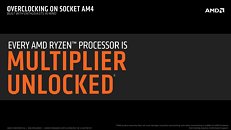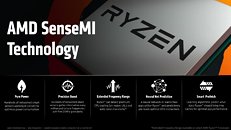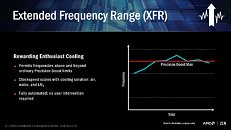Raevenlord
News Editor
- Joined
- Aug 12, 2016
- Messages
- 3,755 (1.20/day)
- Location
- Portugal
| System Name | The Ryzening |
|---|---|
| Processor | AMD Ryzen 9 5900X |
| Motherboard | MSI X570 MAG TOMAHAWK |
| Cooling | Lian Li Galahad 360mm AIO |
| Memory | 32 GB G.Skill Trident Z F4-3733 (4x 8 GB) |
| Video Card(s) | Gigabyte RTX 3070 Ti |
| Storage | Boot: Transcend MTE220S 2TB, Kintson A2000 1TB, Seagate Firewolf Pro 14 TB |
| Display(s) | Acer Nitro VG270UP (1440p 144 Hz IPS) |
| Case | Lian Li O11DX Dynamic White |
| Audio Device(s) | iFi Audio Zen DAC |
| Power Supply | Seasonic Focus+ 750 W |
| Mouse | Cooler Master Masterkeys Lite L |
| Keyboard | Cooler Master Masterkeys Lite L |
| Software | Windows 10 x64 |
A Reddit user has used some good, old-fashioned thinking and inference (along with a good memory for details and investigative spirit) to try and shed some light on AMD's upcoming Ryzen chips - particularly, on the "X" part of their nomenclature.
As we've previously reported, upcoming AMD Ryzen chips will slot in two versions for each model: for example, there will be a R7 1700X, 8-core, 16-thread processor (with 95 W TDP), and expected to retail for $381.72, and a R7 1700 (sans "X"), also 8-core, 16-thread, with a rated TDP at 65 W, expected to retail at $316.59, almost $70 cheaper than the 1700X. Now, with AMD's promise of all Ryzen processors being multiplier unlocked (and thus user - or even through an automatic BIOS - overclockable), this would mean that acquiring the 1700X chip would somehow feel like bad business - after all, if the only difference between the two models were to be base and boost clocks (thus higher pricing and TDP), that would fall irrelevant to most power users, since the ability to overclock their Ryzen processors to those levels would be there anyway.




Essentialy, AMD's "X" nomenclature regarding its upcoming Ryzen chips seems to denote the presence or absence of their touted XFR (eXtended Frequency Range) feature. This is part of AMD's SenseMI Technology suite, which aims to bring higher, intelligent performance to their Ryzen chips through the use of some particular technologies. XFR as it is, appears to be an added, automated overclocking capability to the chip, going further than the Precision Boost clocks would usually allow, supposedly scaling with the cooling performance of the end user's machine. This would fall in nicely with the rated TDP's of the non-X processors being rated at 65 W, with the X-branded, XFR-enabled processors featuring a higher theoretical TDP limit in-line with the capabilities of the XFR feature. As such, while it is true that an AMD Ryzen R7 1700 chip would also have base and boost clocks, much like their 1700X counterpart, the 1700's boost capabilities are designed for the chip not to surpass this 65 W hard limit. The 1700X, however, would be able to dynamically overclock according to the environment and cooling efficiency of the end user's rig, thus allowing it to, in some cases, hit a theoretical power consumption peak at the rated 95 W.
This theory (and AMD's strategy) would go some way to explain the high price difference between the 1700X and the 1700 R7 processors, which have a measly 100 MHz difference in their boost clocks favoring the 1700X (3.8 GHz vs 3.7 GHz on the 1700). After all, it still remains up in the air how good of an overclocker will AMD's ZEN architecture be, but a TDP difference of 30 W could go a long way overclocking-wise, especially when you consider AMD can apparently make these chips tick at 3.8 GHz with a measly 65 W TDP for an 8-core, 16-thread chip.
This strategy also makes sense in that power users who spend money on high-performance cooling solutions are probably more inclined to spend more on a CPU that promises (even if only theoretically) higher overclocking potential (we can expect these X chips to be cherry-picked samples with higher overclockability than other, non-X models). This also makes sense when one considers that the X versions of Ryzen chips are expected to ship with no cooling solution, whereas non-X models will ship with the company's "Wraith" cooling solution, more than enough for the non-power user who doesn't care about something like XFR. While it is a fact that most enthusiast users will simply buy the non-X chips and overclock them until the sky is no longer an achievement, it is also true that even some of us might feel more inclined towards simply "install and forget" high-performance, automatically-overclocked chips (also something the good Dr. Lisa Su mentioned during the "New Horizon" event, saying that XFR was "just for you enthusiast gamers").
View at TechPowerUp Main Site
As we've previously reported, upcoming AMD Ryzen chips will slot in two versions for each model: for example, there will be a R7 1700X, 8-core, 16-thread processor (with 95 W TDP), and expected to retail for $381.72, and a R7 1700 (sans "X"), also 8-core, 16-thread, with a rated TDP at 65 W, expected to retail at $316.59, almost $70 cheaper than the 1700X. Now, with AMD's promise of all Ryzen processors being multiplier unlocked (and thus user - or even through an automatic BIOS - overclockable), this would mean that acquiring the 1700X chip would somehow feel like bad business - after all, if the only difference between the two models were to be base and boost clocks (thus higher pricing and TDP), that would fall irrelevant to most power users, since the ability to overclock their Ryzen processors to those levels would be there anyway.




Essentialy, AMD's "X" nomenclature regarding its upcoming Ryzen chips seems to denote the presence or absence of their touted XFR (eXtended Frequency Range) feature. This is part of AMD's SenseMI Technology suite, which aims to bring higher, intelligent performance to their Ryzen chips through the use of some particular technologies. XFR as it is, appears to be an added, automated overclocking capability to the chip, going further than the Precision Boost clocks would usually allow, supposedly scaling with the cooling performance of the end user's machine. This would fall in nicely with the rated TDP's of the non-X processors being rated at 65 W, with the X-branded, XFR-enabled processors featuring a higher theoretical TDP limit in-line with the capabilities of the XFR feature. As such, while it is true that an AMD Ryzen R7 1700 chip would also have base and boost clocks, much like their 1700X counterpart, the 1700's boost capabilities are designed for the chip not to surpass this 65 W hard limit. The 1700X, however, would be able to dynamically overclock according to the environment and cooling efficiency of the end user's rig, thus allowing it to, in some cases, hit a theoretical power consumption peak at the rated 95 W.
This theory (and AMD's strategy) would go some way to explain the high price difference between the 1700X and the 1700 R7 processors, which have a measly 100 MHz difference in their boost clocks favoring the 1700X (3.8 GHz vs 3.7 GHz on the 1700). After all, it still remains up in the air how good of an overclocker will AMD's ZEN architecture be, but a TDP difference of 30 W could go a long way overclocking-wise, especially when you consider AMD can apparently make these chips tick at 3.8 GHz with a measly 65 W TDP for an 8-core, 16-thread chip.
This strategy also makes sense in that power users who spend money on high-performance cooling solutions are probably more inclined to spend more on a CPU that promises (even if only theoretically) higher overclocking potential (we can expect these X chips to be cherry-picked samples with higher overclockability than other, non-X models). This also makes sense when one considers that the X versions of Ryzen chips are expected to ship with no cooling solution, whereas non-X models will ship with the company's "Wraith" cooling solution, more than enough for the non-power user who doesn't care about something like XFR. While it is a fact that most enthusiast users will simply buy the non-X chips and overclock them until the sky is no longer an achievement, it is also true that even some of us might feel more inclined towards simply "install and forget" high-performance, automatically-overclocked chips (also something the good Dr. Lisa Su mentioned during the "New Horizon" event, saying that XFR was "just for you enthusiast gamers").
View at TechPowerUp Main Site





 The slide that refers to SenseMI specifically says in the lower right corner that XFR will be available on select Ryzen CPUs. Didn't say all. That is of course if that slide is to be believed.
The slide that refers to SenseMI specifically says in the lower right corner that XFR will be available on select Ryzen CPUs. Didn't say all. That is of course if that slide is to be believed.

 I really hope this isn't true and they don't do the same thing they are doing with their GPUs and putting a hard limit on the processor that it can't surpass no matter that the user does. This would be a pretty crappy way to suck and extra $70 out of customers.
I really hope this isn't true and they don't do the same thing they are doing with their GPUs and putting a hard limit on the processor that it can't surpass no matter that the user does. This would be a pretty crappy way to suck and extra $70 out of customers.